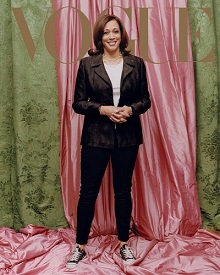
Courtesy of vogue.com
While insurrectionists were storming the Capitol in Washington D.C. on January 6, 2021, another skirmish was playing out in publications like Women’s Wear Daily (WWD) and Vogue. The question, if not weighty, was heated. Why was Kamala Harris, our Vice President-elect, wearing sneakers on the cover of one of the world’s most prestigious fashion magazines? Did the photographer wish to diminish Harri’s stature or make her seem accessible? Everyone in the fashion world had an opinion. Converse, the manufacturer, wasn’t concerned, of course, as copies of those shoes are running out of shop doors.
Men in politics get scant wardrobe attention. True, a reporter once asked Barrack Obama, the 44th U. S. President, why he wore nothing but dark suits. His reply was simple. It made his wardrobe decisions easy. But consistency, too, has a price. The day he appeared in public wearing a tan suit, the country faced a sartorial crisis.
Women are blessed or cursed with a greater variety of style choices. The public expects a show. When Hillary Clinton adopted Obama’s formula and stuck to pantsuits, her critics questioned her femininity. Women leaders around the globe suffer the same scrutiny. Former British Prime Minister Theresa May drew blistering criticism for her tiger print high heels.
The challenge for women under patriarchal rules is to strike a nuanced balance in style because “femininity [is seen] as artifice and masculinity as substance.” Even Supreme Court Justice Sonia Sotomayor chose to forgo her signature red nail polish on the day of her inauguration. Make no mistake, however. Ruth Bader Ginsberg’s decision to wear lace collars over her black robes was a sartorial and political revolution which she used to send messages as well.
Women do use fashion to make statements on numerous public occasions–from the cocktail lounge to the halls of Congress. Suffragettes wore green and purple sashes, shorthand for their voting right demands. Later, white became their color of choice.
When Kamala Harris wore a white pantsuit the evening she accepted the nation’s second-highest office, Vice President of the United States, she was giving a nod to history. That line extended to include Shirley Chisholm, the nation’s first African American woman elected to Congress. She wore white to honor the breaking of a glass ceiling, as did those who followed–women like Geraldine Ferro and Hillary Clinton.
Throughout much of history, women have been obliged to satisfy male expectations. No one should be surprised that during the 2020 campaign, when Harris debated her opponent, Mike Pence, she wore a black pantsuit. She needed to be taken seriously.
Most women in the workplace know there’s a dress code. Congress has long had one for both men and women, though most representatives were caught off guard when then-Speaker of the House, Paul Ryan revived an unwritten and forgotten rule of modesty that barred women from wearing sleeveless attire.
Concern about female fashion isn’t limited to the United States, as I’ve already suggested. One British MP, Rachel Reeves, bemoaned, “If [women] dressed too formally, they were called sexless blue-stockings; if they wore eye-catching or feminine outfits, they were trivialized and condescended to.”
Megha Answer, a teacher of literature, film, and visual culture at Purdue University thinks it’s time for women to stop “playing by rules that men formulate.” The goal is easier said than done because men may set the rules but women sometimes act as enforcers.
One female of prominence who escaped gratuitous criticism was Nancy Regan. Though there were rumblings about her extravagance, few complained about her simple but elegant style. At the same time, no one mistook her to be merely decorative. Her flawless taste with its attention to detail singled her out as a person with whom to be reckoned. She seemed to subscribe to fashion maven Coco Chanel’s edict. “Dress shabbily and they remember the dress; dress impeccably and they remember the woman.”
If Coco is right, what are we to make of Harris’ Converse lace-ups in which she appears on the cover of Vogue? Surely, editor Anna Wintour should have offered a caution even though the outfit was Harris’ choice.
Or, perhaps Wintour sensed a change in the wind. Perhaps she saw, by the donning of those tennis shoes, Harris’ announcement to the world that she is ready to run in her new role. As a former U. S. Senator, she knows she’ll need traction if she is to blaze a trail other women may follow. We want her to surprise us and break a few norms. As Wintour is credited with saying, fashion, as a statement “isn’t about looking back. It is always about looking forward.”
